
Snowboards are boards where both feet are placed, and most times secured, to the same board, which are wider than skis, with the ability to glide on snow. Snowboards widths are between 6 and 12 inches or 15 to 30 centimeters. Snowboards are differentiated from monoskis by the stance of the user. In monoskiing, the user stands with feet inline with direction of travel, whereas in snowboarding, users stand with feet transverse to the longitude of the board. Users of such equipment may be referred to as snowboarders. Commercial snowboards generally require extra equipment such as bindings and special boots which help secure both feet of a snowboarder, who generally rides in an upright position. These types of boards are commonly used by people at ski hills or resorts for leisure, entertainment, and competitive purposes in the activity called snowboarding.

Ice skates are metal blades attached underfoot and used to propel the bearer across a sheet of ice while ice skating.

Skiing, or traveling over snow on skis, has a history of at least eight millennia. The earliest archaeological examples of skis were found in Russia and date to 6000 BCE. Although modern skiing has evolved from beginnings in Scandinavia, 5000-year-old wall paintings suggest use of skis in the Xinjiang region of what is now China; however, this continues to be debated. Originally purely utilitarian, starting in the mid-1800s skiing became a popular recreational activity and sport, becoming practiced in snow-covered regions worldwide, and providing a market for the development of ski resorts and their related communities.

Telemark skiing is a skiing technique that combines elements of Alpine and Nordic skiing. Telemark skiing is named after the Telemark region of Norway, where the discipline originated. Sondre Norheim is often credited for first demonstrating the turn in ski races, which included cross country, slalom and jumping, in Norway around 1868. Sondre Norheim also experimented with ski and binding design, introducing side cuts to skis and heel bindings.

A ski binding is a device that connects a ski boot to the ski. Generally, it holds the boot firmly to allow the skier to maneuver the ski. However, if certain force limits are exceeded, it releases the boot to minimize skier injury, such as in the case of a fall or impact. There are different types of bindings for different types of skiing.
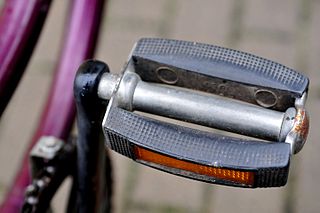
The pedal is the part of a bicycle that the rider pushes with their foot to propel the vehicle. It provides the connection between the cyclist's foot or shoe and the crank allowing the leg to turn the bottom bracket spindle and propel the bicycle's wheels. A pedal usually consists of a spindle that threads into the end of the crank, and a body on which the foot rest is attached, that is free to rotate on bearings with respect to the spindle.
Ski boots are footwear used in skiing to provide a way to attach the skier to skis using ski bindings. The ski/boot/binding combination is used to effectively transmit control inputs from the skier's legs to the snow.
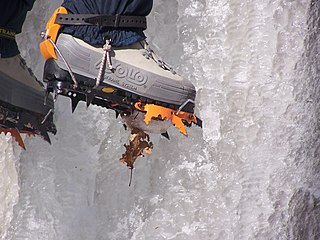
A crampon is a traction device that is attached to footwear to improve mobility on snow and ice during ice climbing. Besides ice climbing, crampons are also used for secure travel on snow and ice, such as crossing glaciers, snowfields and icefields, ascending snow slopes, and scaling ice-covered rock. There are three main attachment systems for footwear: step-in, hybrid, and strap bindings. The first two require boots with welts, as a tension lever attaches the crampon to the heel. The last type are more versatile and can adapt to virtually any boot or shoe, but often do not fit as precisely as the other two types.

Völkl Ski International, GmbH, is a sports equipment manufacturing company based in Germany. Initially it manufactured skis, but has extended its line to snowboards, outerwear, and tennis gear. The American branch is located in Lebanon, New Hampshire along with its wholly owned binding manufacturer, Marker. In 2015 Völkl bought the ski boot manufacturer Dalbello.
adiPURE was a range of football boots developed by the German sportswear manufacturer Adidas and introduced at the end of 2007. The company based the design of the AdiPure on its own boots from the 1978 World Cup. In order to remain practical for the modern game, the boot's construction included updated materials and improved manufacturing techniques, to create a product significantly lighter than its 1978 counterpart.
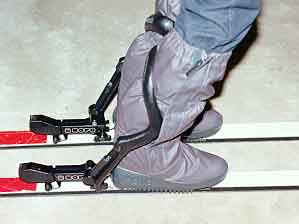
The Nava System was a ski binding and custom ski boot offered for sale in the 1980s. The system used a combination of flexible sole plate to keep the boot centered, and a spring-loaded plastic arm on the rear binding that was used to transmit sideways motions of the leg to the ski. This eliminated the need for a hard shell on the boot; the Nava boot was soft and resembled a knee-high winter boot. In spite of numerous endorsements by racing stars, the system never caught on and sales ended by the late 1980s.

Spademan was a type of ski binding, one of a number of "plate bindings" that were popular in alpine skiing during the 1970s. It used a bronze plate screwed into the bottom of the boot as its connection point, held to the ski by a clamp-like mechanism that grasped the side of the plate. Unlike conventional bindings, the Spademan could release in any direction, in response to any force or torque. It provided greatly improved protection compared to contemporary designs, which generally allowed release of the toe to the sides and heel directly forward, keeping the foot attached in any other fall direction.

Look's Nevada, released in 1950, was the first recognizably modern alpine ski binding. The Nevada was only the toe portion of the binding, and was used with a conventional cable binding for the heel. An updated version was introduced in 1962 with a new step-in heel binding, the Grand Prix. These basic mechanisms formed the basis for LOOK bindings for over 40 years, changing mainly in name and construction materials. The Nevada toe pattern is almost universal among bindings today.

Cable bindings, also known as Kandahar bindings or bear-trap bindings, are a type of ski bindings widely used through the middle of the 20th century. It was invented and brand-named after the Kandahar Ski Club in 1929 by ski racer and engineer Guido Reuge. They were replaced in alpine skiing by heel-and-toe "safety bindings" in the mid-1960s.
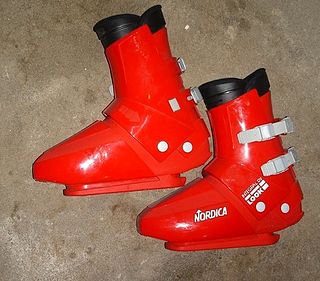
The Look Integral was a downhill ski binding that worked in conjunction with a custom ski boot made by Nordica. The Integral was fairly common in ski rental shops in the 1980s and into the 90s, but has since disappeared.
Hanson Industries invented and popularized the rear-entry ski boot. Formed by brothers Chris and Denny Hanson in 1969, the company became a huge success in the late 1970s. A series of missteps in the early 1980s led to a rapid death spiral and the company went bankrupt in 1984. It was purchased by Daiwa, a Japanese fishing tackle company that handled Hanson's distribution in Japan. Daiwa ended sales in North America and Europe. European products, notably the famous Salomon SX series, used Hanson's exit as a springboard to market domination during the second half of the 1980s. Denny Hanson later introduced the "Apex" design, which combines features of alpine and snowboarding boots.
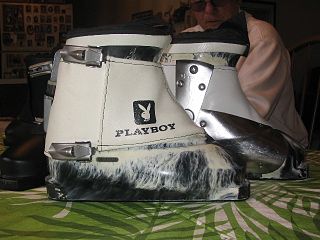
Rosemount Ski Boots introduced one of the earliest all-plastic ski boots for the downhill skiing market, competing with Bob Lange for the title of "first". Rosemount's design was easily distinguished by its use of the uncommon "side-entry" method for putting the boot on, which was rare at the time and is no longer used.

Lange is a major producer of ski boots used in alpine (downhill) skiing. They introduced the world's first plastic ski boots in 1962, and a greatly improved model aimed at the racing market in 1965. After several World Cup and Olympics wins in 1967 and 1968 made them a must-have on the circuit, Lange has remained a force in the racing market ever since. Their boots have equipped five times as many World Cup medal winners as any other brand into the 2000s. The front-entry design introduced by Lange is used by almost every modern ski boot to this day. Lange remains a major brand worldwide.

The Flexon was a downhill ski boot introduced by Raichle in the winter of 1980/81. Based on designs by Sven Coomer, Al Gross and Erik Giese, the Flexon used a unique system to control forward flex in a predictable way, as well as making the boot more comfortable and easier to put on and remove. The basic layout was, and is, generally referred to as a "three-piece" design -- three-piece boots preceding the Flexon included the Henke Strato, Nordica Comp 3 and a dozen other designs from Italian bootmakers.
This glossary of skiing and snowboarding terms is a list of definitions of terms and jargon used in skiing, snowboarding, and related winter sports.

















